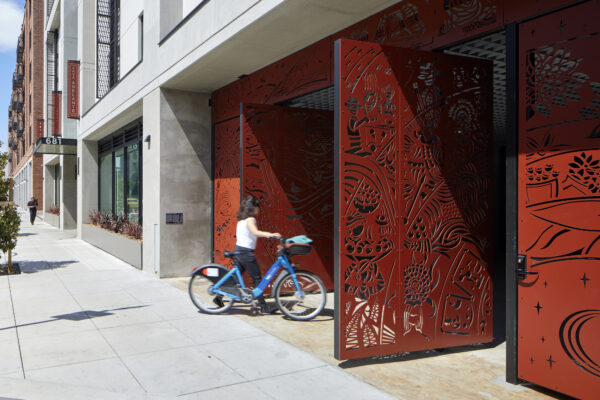Date Posted: 12.12.2024
Cultura y Arte Nativa de las Americas (CANA) celebrated the grand opening of the Indigenous Peoples Cultural Arts Healing Center today. Designed by Mithun, the 9,250-square-foot facility will serve as a new community arts hub for the surrounding neighborhood in support of cultural place-keeping in the Mission.
“Eight years ago, we envisioned a giant, double-height cultural gathering space, stretching the full depth of the block, with maximum street visibility and programmatic flexibility — a true stake in the ground for the Arts in the Mission District,” says Mithun senior associate Logan Kelley. “Today, CANA moves into this incredible space, and we couldn’t be happier to celebrate with them. We are nothing without the Arts! ¡Adelante!”
The new Center expands CANA’s ability to host large events that occupy the entire ground floor, as well as divide the space to accommodate multiple concurrent programs and events, including classes and meetings, recording, production and other arts and educational activities. The double-height performance and rehearsal spaces are supported by a kitchen, dressing rooms and showers.
“After more than 44 years of existence, Carnaval San Francisco and other CANA projects and partners will finally have a lifetime permanent casa to call home at 683 Florida Street in the Mission District of San Francisco,” says CANA CEO Roberto Hernandez.
The $7.9 million build-out and renovation is located on the ground floor of Casa Adelante at 681 Florida, a 130-unit permanently affordable-housing complex also designed by Mithun.
In addition to the interior spaces, the Center’s entry features a large gate with laser-cut metal panels that celebrate this presence and provide secure outdoor activity area for CANA’s community arts programs. The design was developed by San Francisco public high school students as part of Youth Art Exchange, led by local Mission District artist Alyssa Aviles and Mithun’s own Logan Kelley, and funded by the city’s 1% for Art program.

Through block-printing, hand-drawing and collaging, the youth artists explored various themes and solicited feedback from project stakeholders. The final piece is a collaboration amongst the students, with each artist responsible for various areas and expressions. The sun and moon represent how all of Earth is connected under a single cycle of nature, and the never-ending cycle of rebirth on Earth. Quetzalcóatl, the Aztec god, extends from sun to moon, unifying all creatures and protecting the important cultural space that lies beyond this gate. The featured animals represent local, migratory species which echoes the Mission District’s rich history of migration and cultural mixing. Panaderas, floristas, músicos, bailarines, and craftspeople are depicted throughout the scene, amongst regional plants and flowers. Bits of San Francisco outside the Mission are also scattered throughout the piece, reminding us that this neighborhood is just one within a rich network of cultural identities.
The building’s forecourt dissolves the boundary between public and private—a legacy of the Mission District’s cultural heritage. It provides a venue for CANA and associated arts organizations to spill out onto the street, serving as a prime starting point for their annual Carnaval parade.
Mithun provided architecture and interior design services. Additional design team members included STRUCTUS, Inc, structural; Engineering350, MEP; Salter, Inc., acoustical and AV; Endelman & Associates, accessibility; and Techlinea, Inc., lighting design.